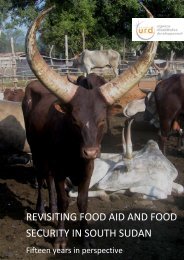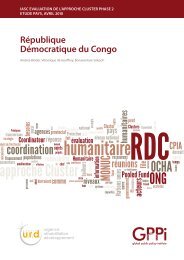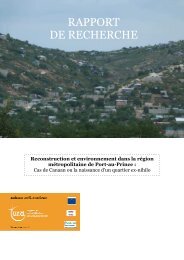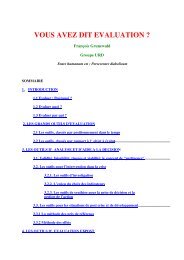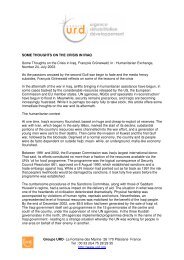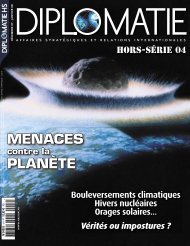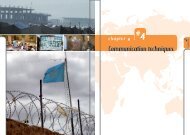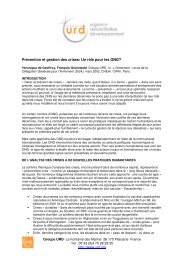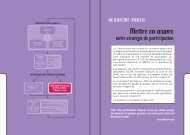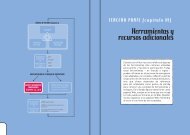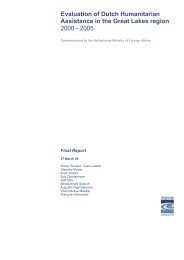Kabul Urban Survey - Groupe URD
Kabul Urban Survey - Groupe URD
Kabul Urban Survey - Groupe URD
Create successful ePaper yourself
Turn your PDF publications into a flip-book with our unique Google optimized e-Paper software.
Need for flexible urban plans<br />
The other challenge for urban plan designers is to produce flexible plans which allow<br />
for potential consultation and evolution.<br />
5.3.4 <strong>Kabul</strong> Municipality mapping<br />
Pathak considers that the KM urban planning office has a significant potential of architects<br />
and engineers that would be capable of establishing urban plans, after appropriate training.<br />
They need to update their knowledge. For now, the map drawing office and skills are too<br />
weak in KM office. They “are working from the foundation of the 1978 Soviet Master Plan.<br />
Muhammad Ali, one of the staff members trained at AIMS, is still hand-drawing plans for a<br />
new residential zoning area in a neighbourhood in west <strong>Kabul</strong>.” 37 “There are some ongoing<br />
attempts of capacity building of the existing KM staff. Regular English, computers and GIS<br />
courses are organized by the Independent Administrative Reform and Civil Service<br />
Commission (IARCSC) and UNDP/AIMS program. Trainings sessions are also being<br />
conducted by national and international advisors on strategic city planning and financial<br />
management. But, the current knowledge and skill base is so low that it will take several<br />
years for the prerequisite capacity to be built.” 38<br />
Comments<br />
The absence of a consensus on spatial vision is one of the main problems facing all<br />
institutional, international and private urban actors. This issue is linked to:<br />
- lack of global urban data (demography, social, poverty, economic),<br />
- lack of urban plans, or outdated graphic administrative documents,<br />
- weak capacities in urban planning and in generating digital plans with insufficient<br />
computer equipment,<br />
- difficulties of cooperation between the two main urban actors, the Ministry of <strong>Urban</strong><br />
Development and <strong>Kabul</strong> Municipality<br />
- Weak communication within the MUD<br />
5.3.5 AGCHO & AIMS as mapping offices<br />
Before all urban skills within MoUD and KM can be updated, an international organisation<br />
has been trying to fill the gap. This initiative is contested, by afghan cartography office<br />
(AGCHO).<br />
AIMS, as international UN actor, and AGCHO, as Afghan mapping institution<br />
AGCHO is an institution that lies within central government, like a ministry. Its role is to<br />
provide “every kind of land survey, map and mapping activities in Afghanistan… It is also<br />
involved in surveying for the future gas pipeline linking Turkmenistan to the Arabian Sea.” 39<br />
To cope the lack of urban plans, AIMS was set up by the UN to provide and share spatial<br />
information products and services within the international community as well as to share<br />
spatial vision with Afghan institutions. Their work consists of elaborating a wide range of map<br />
products, database design and distributing of documents. “The UNDP programme<br />
Afghanistan Information Management Services (AIMS) has worked closely with <strong>Kabul</strong><br />
Municipality and the Afghanistan Geodesic and Cartographic Head Office (AGCHO) to<br />
digitalize, reform and refine <strong>Kabul</strong>’s map 40 . The process of urban mapping, as an<br />
unavoidable base for any programme, is sufficiently important and complex, as explained by<br />
S. Hegland (UNDP) below.<br />
37 Hegland S., UNDP, Afghanistan Management Information is mapping <strong>Kabul</strong> and Progress Towards<br />
Development, 2004<br />
38 Pathak P., <strong>Kabul</strong>, February 2006, “ <strong>Urban</strong> Policy, priorities and Recommendations for <strong>Kabul</strong>”, in<br />
chapter: “Inadequate Capacity for <strong>Urban</strong> Development Planning and Management” p 10.<br />
39 idem note HEGLAND, UNDP<br />
40 idem note HEGLAND, UNDP<br />
Page 56



